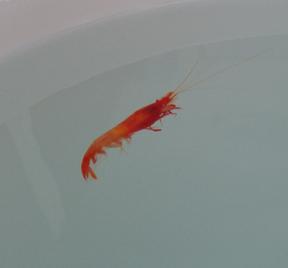1 September, 2001
More to Life � Than Rocks
Although much emphasis has been placed on the importance of rocks during
our expedition, there is life beyond the geology of Gakkel Ridge. A marine
ecologist (a scientist who studies the interactions of living and nonliving
things in an ocean environment) is a member of the scientific party, and
her quest for organisms is very important in the exploration of Gakkel Ridge
Linda Kuhnz, from Moss Landing Laboratories near Monterey, CA, is an
ecologist who studies marine environments. She is a scientist who loves
what she does and is constantly amazed as she learns about the diversity in
the world's organisms. As Gakkel Ridge is an unexplored region of the
world, the possibility of discovering organisms here is especially exciting.
The first question-- what is the ocean floor like at Gakkel Ridge? Are
hydrothermal vents present? If so, what animals can be found making their
habitats around them? The Arctic Ocean is an ocean basin that is quite
isolated from the world's other oceans, so how did species find their way
in?
These are questions that Linda is looking to answer, and the rock dredges
that have been going on have been the place to begin the search for
answers. When a dredge hauls in rocks from the ocean floor, it travels up
through several miles of water before reaching the ship's deck. A living
thing captured in it may have come from the floor itself or have been
swimming along in the water column when luck wasn't on its side. Either
way, when found in the dredge net, the animal is typically dead from the
trauma of its ascent through the water or ocassionaly from being smashed on
the rocks. However, this doesn't disappoint Linda as they are generally
still in good form. Whenever a living thing arrives on the deck, it is
immediately preserved in one or more chemicals or by freezing (minus 185
degrees F). Linda can examines each species while we are here, but a
thorough analysis is better done in her laboratory once we are back home.
So what creatures have been collected from the Gakkel Ridge area? As of
today, the animals that have been recovered include 2 types of shrimp, 3
jellyfish, numerous sponges, and ctenophores (jellyfish-like organisms
without stinging cells that make their own light). The shells of clams and
marine snails have also been brought up, and water and mud samples may
reveal microscopic animals and bacteria.
As organisms are adapted for their surroundings, experts like Linda can
tell much about them. For example, color can be a sign of where an animal
lives. The dark red coloration of the shrimps found here indicates that
they probably lived not in shallow, but instead deep water where they were
undetectable to predators. Colorless eyes is another clue that life was in
a dark environment where senses other than sight are important. On another
level, the chemistry of the organism such as the hormones and enzymes it
produces may tell if it lived near in a certain area such as a sulfuric
hydrothermal vent environment. So you can see that there is much work to
be done on each specimen before thorough conclusions can be drawn.

<> An Arctic shrimp that was recovered from a dredge.

<> Linda Kuhnz, a marine ecologist, looks up from her specimens. The blue bucket contains sponges that were brought up from the ocean floor.
Contact the TEA in the field at
.
If you cannot connect through your browser, copy the
TEA's e-mail address in the "To:" line of
your favorite e-mail package.
|
